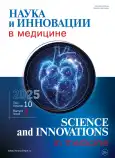Оценка морфологической структуры децеллюляризованной человеческой амниотической мембраны
- Авторы: Кучук К.Е.1, Волова Л.Т.2, Новиков И.В.2, Милюдин Е.С.2
-
Учреждения:
- ГБУЗ «СОКОБ имени Т.И. Ерошевского»
- ФГБОУ ВО «Самарский государственный медицинский университет» Минздрава России
- Выпуск: Том 10, № 3 (2025)
- Страницы: 188-194
- Раздел: Биотехнология
- URL: https://journal-vniispk.ru/2500-1388/article/view/312148
- DOI: https://doi.org/10.35693/SIM646547
- ID: 312148
Цитировать
Аннотация
Цель – изучить морфологическую структуру лиофилизированной амниотической мембраны, предварительно подвергнутой децеллюляризации физическим методом.
Материал и методы. Экспериментальное исследование сохранности анатомической структуры лиофилизированной амниотической мембраны (АМ) было выполнено на четырех группах фрагментов амниотической мембраны. Первая группа – АМ, пропитанная глицерином и высушенная над силикагелем; вторая группа – АМ, пропитанная глицерином и обработанная ультразвуком, лиофилизированная; третья группа – АМ, обработанная ультразвуком и лиофилизированная; четвертая группа – нативная АМ, не консервированная.
Выполнено изучение биоматериала с помощью световой микроскопии и сканирующей электронной микроскопии.
Результаты. Физические методы воздействия на биологическую ткань ожидаемо оказывают влияние на жизнеспособность клеток и позволяют получить полностью децеллюляризованную амниотическую мембрану. Дополнительная обработка АМ глицерином перед физическим воздействием с целью децеллюляризации достоверно не способствует сохранению клеточных структур. При этом необходимо отметить, что в амниотической мембране, пропитанной глицерином, после физического воздействия сохраняется значимо больше фрагментов мембран эпителиальных клеток и более сохранна базальная мембрана.
Выводы. Разработанный нами метод децеллюляризации с использованием физических методов не подразумевает внесения в обрабатываемый биоматериал каких-либо химических веществ, которые впоследствии могут оказать непредсказуемое воздействие на окружающие имплантированную АМ регенерирующие ткани. Также консервация АМ предложенным способом лиофилизации позволяет получить морфологически целостный, эластичный и прочный биоматериал для регенеративной медицины.
Полный текст
Открыть статью на сайте журналаОб авторах
К. Е. Кучук
ГБУЗ «СОКОБ имени Т.И. Ерошевского»
Email: kuchukke@rambler.ru
ORCID iD: 0009-0003-2986-5913
врач-офтальмолог, заведующая отделением заготовки и консервации тканей
Россия, СамараЛ. Т. Волова
ФГБОУ ВО «Самарский государственный медицинский университет» Минздрава России
Email: l.t.volova@samsmu.ru
ORCID iD: 0000-0002-8510-3118
д-р мед. наук, профессор, директор НИИ «БиоТех»
Россия, СамараИ. В. Новиков
ФГБОУ ВО «Самарский государственный медицинский университет» Минздрава России
Email: р111аа@yandex.ru
ORCID iD: 0000-0002-6855-6828
канд. мед. наук, ассистент кафедры травматологии, ортопедии и экстремальной хирургии имени академика РАН А.Ф. Краснова
Россия, СамараЕвгений Сергеевич Милюдин
ФГБОУ ВО «Самарский государственный медицинский университет» Минздрава России
Автор, ответственный за переписку.
Email: e.s.milyudin@samsmu.ru
ORCID iD: 0000-0001-7610-7523
д-р мед. наук, доцент кафедры оперативной хирургии и клинической анатомии с курсом медицинских информационных технологий
Россия, СамараСписок литературы
- Meller D, Pires RT, Mack RJ, et al. Amniotic membrane transplantation for acute chemical or thermal burns. Ophthalmology. 2000;107(5):980-9; discussion 990. doi: 10.1016/s0161-6420(00)00024-5
- Niknejad H, Peirovi H, Jorjani M, et al. Properties of the amniotic membrane for potential use in tissue engineering. Eur Cell Mater. 2008;15:88-99. doi: 10.22203/ecm.v015a07
- Pollard SM, Aye NN, Symonds EM. Scanning electron microscope appearances of normal human amnion and umbilical cord at term. Br J Obstet Gynaecol. 1976;83(6):470-7. doi: 10.1111/j.1471-0528.1976.tb00868.x
- Adds PJ, Hunt CJ, Dart JK. Amniotic membrane grafts, “fresh” or frozen? A clinical and in vitro comparison. Brit J Ophthalmol. 2001;85(8):905-7. doi: 10.1136/bjo.85.8.905
- Aleksandrova OI, Gavrilyuk IO, Mashel TV, et al. On preparation of amniotic membrane as a scaffold for cultivated cells to create corneal bioengineering constructs. Saratov Journal of Medical Scientific Research. 2019;15(2):409-413. [Александрова О.И., Гаврилюк И.О., Машель Т.В., и др. К вопросу о подготовке амниотической мембраны в качестве скаффолда для культивируемых клеток при создании биоинженерных конструкций роговицы. Саратовский научно-медицинский журнал. 2019;15(2):409-413]. URL: https://ofmntk.ru/files/upload/2019215.pdf
- Li H, Niederkorn JY, Neelam S, et al. Immunosuppressive Factors Secreted by Human Amniotic Epithelial Cells. Invest Ophthalmol Vis Sci. 2005;46(3):900-907. doi: 10.1167/iovs.04-0495.
- Koizumi NJ, Inatomi TJ, Sotozono CJ, et al. Growth factor mRNA and protein in preserved human amniotic membrane. Curr Eye Res. 2000;20(3):173-7. PMID: 10694891
- Riau AK, Beuerman RW, Lim LS, Mehta JS. Preservation, sterilization and de-epithelialization of human amniotic membrane for use in ocular surface reconstruction. Biomaterials. 2010;31(2):216-25. doi: 10.1016/j.biomaterials.2009.09.034
- Adds PJ, Hunt CJ, Dart JK. Amniotic membrane grafts, “fresh” or frozen? A clinical and in vitro comparison. Br J Ophthalmol. 2001;85(8):905-7. doi: 10.1136/bjo.85.8.905
- Milyudin ES. Technology of preservation of the amniotic membrane by drying with silica gel. Technologies of living systems. 2006;3(3):44-49. (In Russ.). [Милюдин Е.С. Технология консервации амниотической мембраны путем высушивания над силикагелем. Технологии живых систем. 2006;3(3):44-49].
- Milyudin ES, Kuchuk KE, Bratko OV. Preserved amniotic membrane in a small tissue-engineering complex of the anterior corneal epithelium. Perm Medical Journal. 2016;33(5):47-54. [Милюдин Е.С., Кучук К.Е., Братко О.В. Консервированная амниотическая мембрана в структуре тканеинженерного комплекса переднего эпителиального слоя роговицы. Пермский медицинский журнал. 2016;33(5):47-54]. doi: 10.17816/pmj33547-53
- Kim JC, Tseng SCG. Transplantation of preserved human amniotic membrane for surface reconstruction in severly damaged rabbit corneas. Cornea. 1995;14:473-484. PMID: 8536460
- Koizumi N, Fullwood NJ, Bairaktaris G, et al. Quantock Cultivation of Corneal Epithelial Cells on Intact and Denuded Human Amniotic Membrane. Investigative Ophthalmology & Visual Science. 2000;41:2506-2513. PMID: 10937561
- Lin CH, Hsia K, Su CK, et al. Sonication-Assisted Method for Decellularization of Human Umbilical Artery for Small-Caliber Vascular Tissue Engineering. Polymers (Basel). 2021;13(11):1699. doi: 10.3390/polym13111699
- Melkonyan KI, Rusinova TV, Kozmai YaA, Asyakina AS. Assessment of Nuclear Material Elimination by Different Methods of Dermis Decellularization. Journal Biomed. 2021;17(3E):59-63. [Мелконян К.И., Русинова Т.В., Козмай Я.А., Асякина А.С. Оценка элиминации ядерного материала при различных методах децеллюляризации дермы. Биомедицина. 2021;17(3E):59-63]. doi: 10.33647/2713-0428-17-3E-59-63
- Murphy SV, Skardal A, Nelson RAJr, et al. Amnion membrane hydrogel and amnion membrane powder accelerate wound healing in a full thickness porcine skin wound model. Stem Cells Transl Med. 2020;9(1):80-92. doi: 10.1002/sctm.19-0101
- Startseva OI, Sinelnikov ME, Babayeva YuV, Trushenkova VV. Decellularization of organs and tissues. Pirogov Russian Journal of Surgery. 2019;(8):59-62. [Старцева О.И., Синельников М.Е., Бабаева Ю.В., Трущенкова В.В. Децеллюляризация органов и тканей. Хирургия. Журнал им. Н.И. Пирогова. 2019;(8):59-62]. doi: 10.17116/hirurgia201908159
- Tovpeko DV, Kondratenko AA, Astakhov AP, et al. Decellularization of organs and tissues as a key stage in the creation of biocompatible material. Bulletin of the Military Innovation Technopolis “Era”. 2023;4(4):342-346. [Товпеко Д.В., Кондратенко А.А., Астахов А.П., и др. Децеллюляризация органов и тканей как ключевой этап создания биосовместимого материала. Вестник Военного инновационного технополиса «Эра». 2023;4(4):342-346]. doi: 10.56304/S2782375X23040150 EDN: IHEIWC
Дополнительные файлы
















